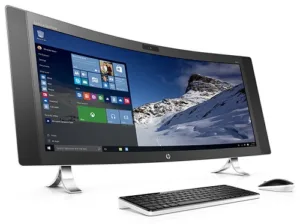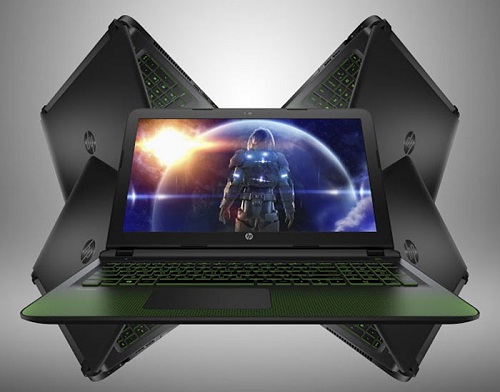Notebooks were the main attraction at the event, with four new models introduced, ranging from 11.6″ to 15.6″. The first and largest model was the Pavilion Gaming Notebook, which has a discrete (GTX 950M) GPU and Core i5 or i7 Skylake processors.
Resolution begins at 1366 x 768, with 1920 x 1080 available as an upgrade. A Realsense camera can also be used to replace the standard webcam. Storage varies from a 128GB SSD to a 2TB HDD (or combination of the two) and RAM is up to 16GB. Battery life is up to eight hours. HDMI, USB 3.0 (x2), USB 2.0 and RJ45 ports are featured.
The Pavilion model is a more affordable ($900) option to HP’s last entry to the gaming notebook space: the Omen, which cost $1,500 (HP Predicts The Omen Will be Gaming’s Future). It will be released on the 8th November.
Coming in at the same size as the Spectre, HP’s Envy Notebook now runs Windows 10 and is said to be the company’s thinnest notebook yet (under 13mm). The starting model has 1920 x 1080 resolution, but this can be upgraded to 3200 x 1800. An interesting design change is in the hinge connecting the display to the body: it is purposefully made larger than normal, so opening the display elevates the chassis. HP says that this provides a better typing experience and improves heat dissipation.
Once again, Skylake processors are used, with a maximum of 8GB of RAM and a 512GB SSD. Battery life is up to 10 hours. HDMI, USB 3.0 (x4) and RJ45 ports are featured. The laptop will go on sale on the 18th October, for $900.
The final notebooks to be announced were new versions of the low-cost Stream 11 (11.6″) and Stream 13 (13.3″). These new models have a longer battery life (up to 10.5 or 8.5 hours, respectively) and new Intel Celeron processor. They will be launched on the 18th October, for $200 (11.6″) and $250 (13.3″).


